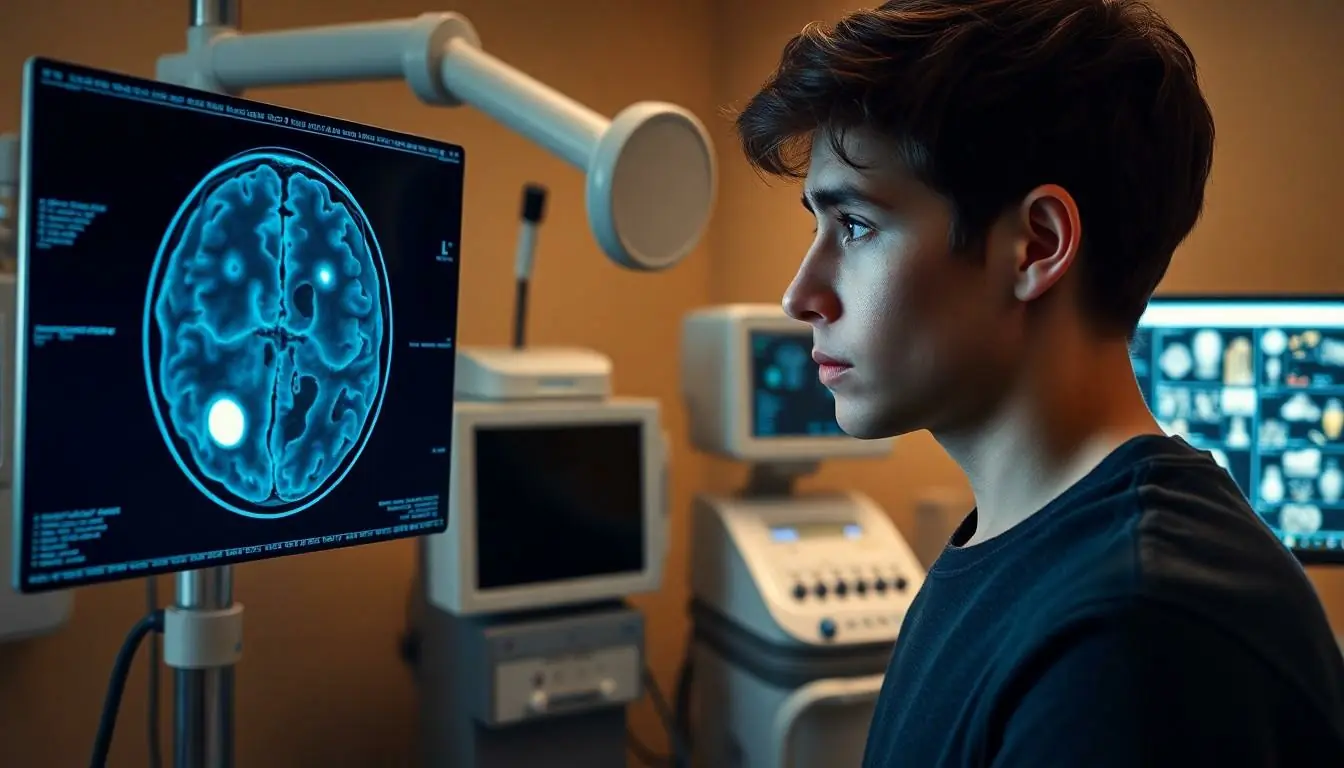Table of Contents
ToggleWhen young adults hear the term “white spots on brain MRI,” it might sound like a quirky new trend in brain fashion. But these mysterious spots can raise eyebrows and questions. Are they just harmless flecks or signals of something more serious? The truth is, while many young people might dismiss them as nothing to worry about, understanding their significance is crucial for peace of mind.
In a world where health information is just a click away, navigating the realm of brain imaging can feel like trying to read a foreign language. With a dash of humor and a sprinkle of knowledge, this article aims to demystify those white spots. From potential causes to what they really mean, it’s time to decode the enigma and ensure that those spots don’t turn into a source of unnecessary anxiety. Let’s dive in and uncover the truth behind the white spots on brain MRIs.
Understanding White Spots on Brain MRI Young Adults
White spots on a brain MRI can raise concerns in young adults. These spots, known as hyperintensities, might indicate various conditions. Identifying the underlying cause remains essential for accurate diagnosis.
Common causes of white spots include small vessel disease and migraine-related changes. Small vessel disease often results from risk factors like high blood pressure and diabetes. Symptoms rarely accompany these spots, but their presence warrants further evaluation.
Certain autoimmune disorders can also contribute to white spots. Conditions like multiple sclerosis (MS) may present as lesions on MRI scans. Medical professionals typically assess the patient’s entire clinical picture, including any neurological symptoms.
Infections can lead to white matter changes as well. Viral encephalitis, for example, might cause abnormal findings on MRI. Diagnosing the specific cause often requires a thorough medical history and additional tests.
Cancer, although less common, occasionally presents as white spots. Primary brain tumors or metastases can create similar lesions. Early detection improves treatment options, making prompt investigation crucial.
Variability exists in interpreting MRI results. Radiologists often consider the patient’s age, health history, and symptoms when analyzing findings. Engaging in discussions with healthcare providers about MRI results helps clarify concerns and next steps.
Causes of White Spots
White spots on brain MRI can stem from various underlying issues. Understanding these causes aids in recognizing their significance.
Vascular Issues
Vascular problems frequently contribute to white spots. Small vessel disease leads to reduced blood flow, resulting in hyperintensities. Conditions such as hypertension and diabetes can exacerbate these changes. Reduced blood supply often indicates potential risks for future strokes or cognitive decline. Young adults may overlook these signs but addressing them promptly enhances overall health.
Inflammatory Conditions
Inflammatory conditions play a vital role in white spot development. Multiple sclerosis, for instance, causes lesions due to immune system attacks on the myelin sheath. Migraine-related changes also create hyperintensities, impacting the brain’s vascular structure. These inflammatory responses can arise from infections, autoimmune disorders, and other neurological issues. Early detection and intervention are essential to managing these conditions effectively.
Other Possible Causes
Various other factors can lead to white spots on brain MRI. Infections like viral encephalitis impact the central nervous system, generating hyperintensities. Tumors, though less common, also present as white spots and require thorough evaluation. Additionally, chronic migraines and certain genetic factors contribute to abnormal findings. Identifying the underlying cause is crucial for appropriate diagnosis and treatment.
Symptoms and Diagnosis
Recognizing symptoms associated with white spots on a brain MRI is crucial for young adults. Some individuals might experience headaches, dizziness, or cognitive difficulties. Changes in vision could also occur, alongside sensations like tingling or numbness in extremities. While symptoms vary from person to person, it’s essential not to overlook these signs, as they may indicate underlying health issues.
MRI interpretation requires expertise. Radiologists assess the characteristics of white spots, including their size and location. Correlating these features with the patient’s clinical history enhances the diagnostic process. Variability in results exists, especially for young adults, since many factors like age and health history influence findings. Medical professionals often order follow-up tests to clarify ambiguous results and ensure accurate diagnosis. Clear communication between doctor and patient remains vital for effective treatment planning.
Treatment Options
Identifying treatment options for white spots on a brain MRI is essential for young adults facing potential health implications. Various approaches exist depending on the underlying cause of the hyperintensities.
Medication
For certain conditions, medication plays a critical role in managing symptoms and preventing further complications. Individuals diagnosed with autoimmune diseases may require immunomodulatory therapies to reduce inflammation. Patients with migraine-related changes often benefit from preventive migraine medications, which can help decrease the frequency and severity of attacks. Anticoagulants or antiplatelet agents might be necessary for those with vascular issues, reducing stroke risks. Consulting a physician ensures an appropriate treatment plan tailored to individual health needs, emphasizing communication about symptoms and response to medications.
Lifestyle Changes
Implementing lifestyle changes significantly enhances brain health and overall well-being. Regular physical activity promotes cardiovascular health and may improve blood flow to the brain. Diet rich in fruits, vegetables, and omega-3 fatty acids supports neurological function and reduces inflammation. Stress management techniques, such as mindfulness and yoga, can decrease anxiety linked to health concerns. Normalizing sleep patterns also supports cognitive health and recovery. By prioritizing these lifestyle modifications, young adults can actively participate in managing their health while addressing potential risks associated with white spots on MRIs.
Impact on Young Adults’ Health
White spots on brain MRIs can impact young adults’ health significantly. Cognitive decline often poses a major concern linked to these hyperintensities. Small vessel disease disrupts blood flow, raising the risk for strokes in this demographic. Inflammatory conditions, such as multiple sclerosis, lead to further complications that may affect daily functioning.
Symptoms commonly associated with white spots shouldn’t be ignored. Headaches and dizziness could signal underlying issues requiring immediate attention. Changes in vision may indicate further complications, emphasizing the need for evaluation. Tingling or numbness in extremities often warrants further investigation as well. Recognizing these symptoms empowers individuals to seek timely medical advice.
Quality of MRI interpretation plays a crucial role in determining health outcomes. Radiologists assess characteristics of white spots thoroughly and correlate them with the patient’s history. Variability in results can cause confusion, particularly among young adults. Follow-up tests can clarify ambiguous findings, ensuring proper diagnosis.
Communication with healthcare providers remains essential for young adults. Discussing symptoms openly promotes better understanding and treatment planning. Effective conversations between patients and doctors lead to tailored interventions. Prioritizing lifestyle changes, like engaging in regular exercise and maintaining a healthy diet, also contributes to overall brain health. Managing stress through mindfulness or relaxation techniques enhances wellbeing, providing additional benefits.
Understanding the connections between white spots and potential health risks fosters an informed approach to medical care. Prioritizing these actions can help mitigate anxiety surrounding brain MRI results. Young adults play an active role in their health management by addressing concerns based on medical advice.
Conclusion
White spots on brain MRIs shouldn’t be dismissed, especially in young adults. While they may seem harmless, these hyperintensities can signal underlying health issues that require attention. Understanding their potential causes is essential for alleviating anxiety and ensuring proper care.
Recognizing associated symptoms is crucial for early intervention. Engaging in open dialogue with healthcare providers can lead to more accurate diagnoses and effective treatment plans. By prioritizing brain health through lifestyle changes and proactive medical discussions, young adults can take charge of their well-being and address any concerns that arise from MRI findings.








